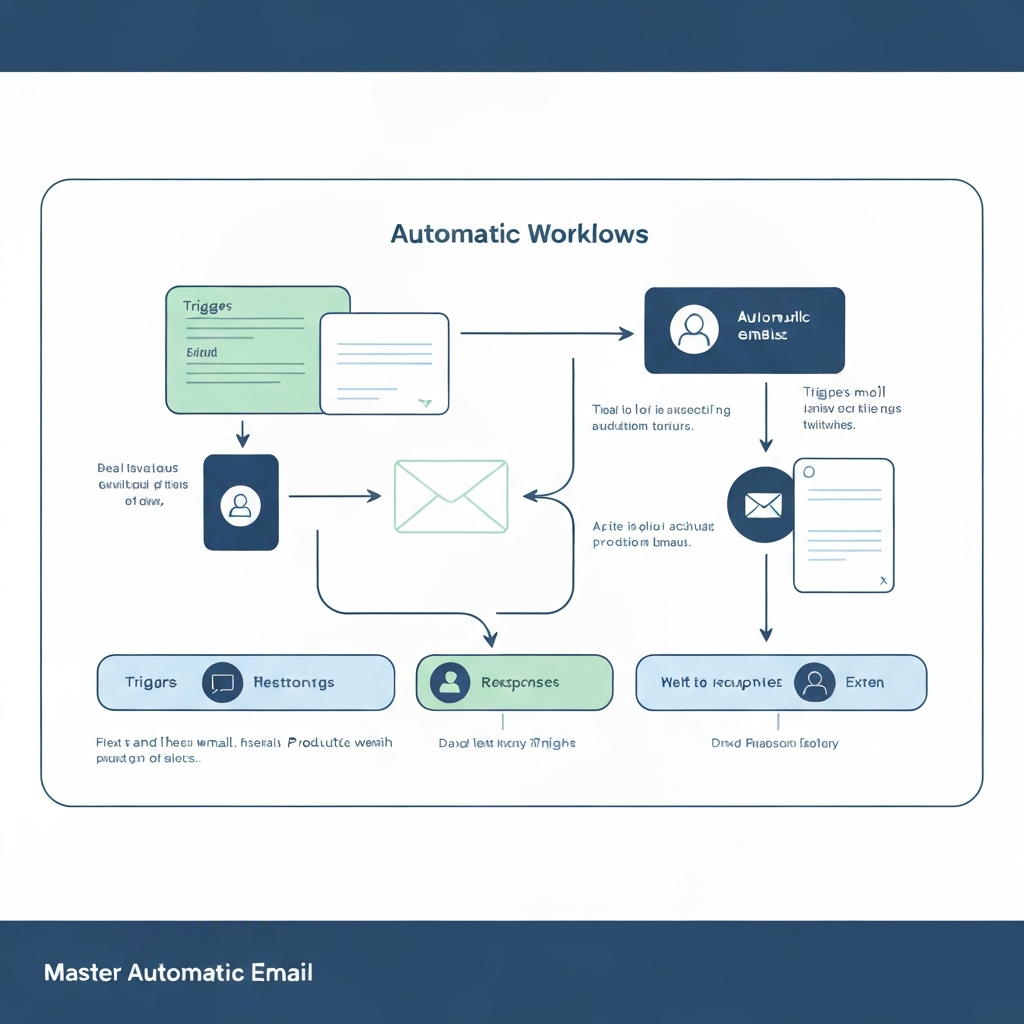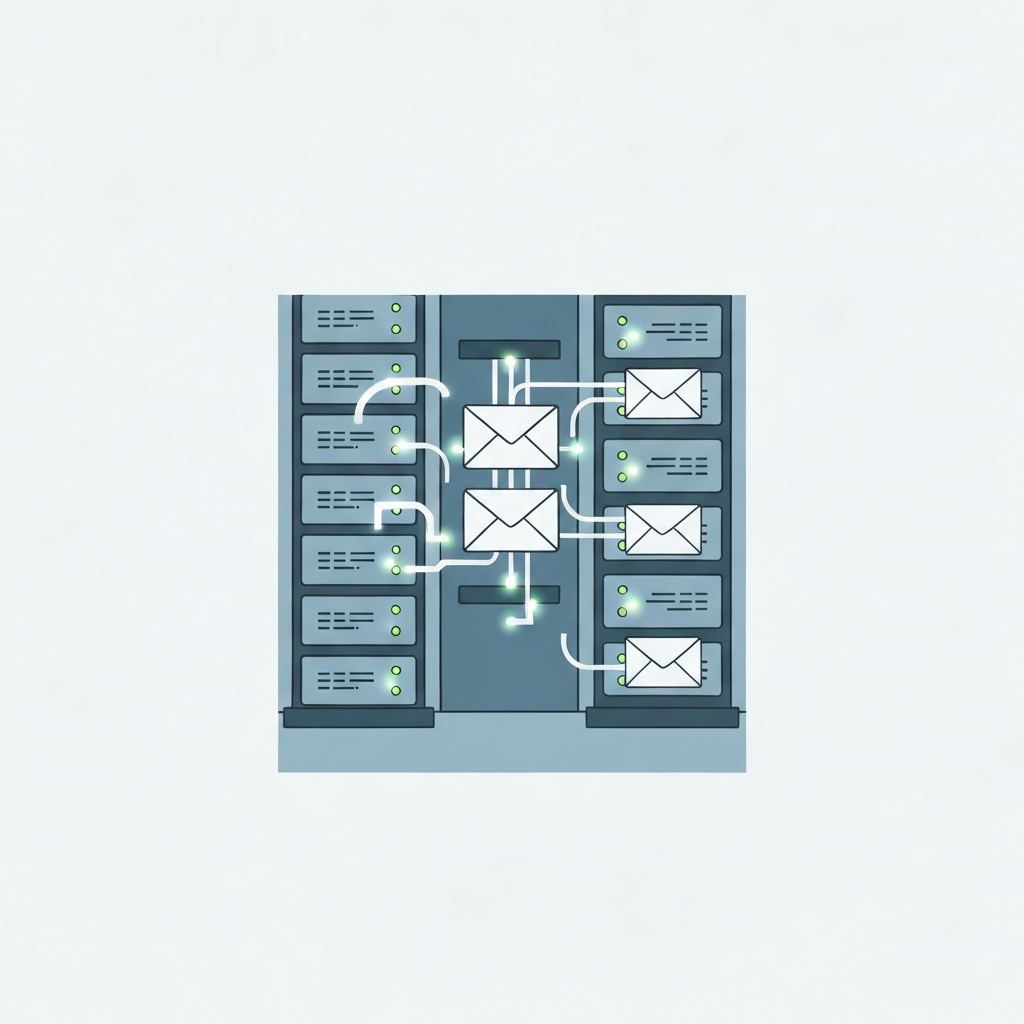Master Automatic Email: Boost Productivity Now

The relentless ping of new emails. The growing number of unread messages that loom like an insurmountable mountain. For many professionals, the inbox has become a source of stress, a time sink, and a barrier to genuine productivity. In today's fast-paced business world, drowning in emails is not just an inconvenience; it's a significant impediment to success. But what if there was a way to tame this digital beast? What if your inbox could manage itself, intelligently prioritizing, responding, and organizing, freeing you to focus on what truly matters? This is the promise of automatic email, and with the advent of advanced AI, it's no longer a futuristic concept but a powerful reality.
Gone are the days when "automatic email" meant little more than a basic "out of office" reply. Today, sophisticated AI-powered solutions are transforming how we handle our digital communications, offering a level of efficiency and intelligence previously unimaginable. This article will guide you through the evolving landscape of automatic email, revealing how these tools can revolutionize your workflow, alleviate inbox overload, and dramatically boost your email productivity.
Introduction to Automatic Email and Its Evolution
At its core, automatic email refers to any email communication that is sent or managed without direct, manual intervention for each instance. The simplest form, the auto-responder, has been around for decades, primarily used for acknowledging receipt or notifying senders of absence. Think of the classic "Thank you for your message, I am currently out of the office..." auto-reply. While functional, these systems are rudimentary, relying on predefined rules and lacking any understanding of context or urgency.
The evolution from these basic auto-responders to modern AI email tools has been nothing short of remarkable. Early automation efforts focused on simple rule-based systems: "If sender is X, then move to folder Y." While helpful for basic organization, these systems were rigid and easily overwhelmed by the sheer volume and complexity of modern communication. The real game-changer has been the integration of Artificial Intelligence. AI allows email systems to move beyond simple rules and begin to understand, learn, and adapt. This shift is fundamental to achieving true email efficiency and effectively managing your inbox.
According to MailerLite, email automation uses pre-set triggers or schedules to send targeted messages, saving you time while ensuring timely, relevant communication. This principle, when applied intelligently, forms the backbone of modern automatic email solutions. The goal is no longer just to send an email; it's to manage the entire communication lifecycle with unprecedented smarts.
Beyond Auto-Responders: Understanding Advanced AI-Powered Email Automation
The distinction between traditional auto-responders and advanced, AI-powered automatic email systems is vast. While an auto-responder is a one-way street – sending a pre-written message based on a simple trigger – AI automation is a dynamic, intelligent assistant. It doesn't just react; it analyzes, predicts, categorizes, and suggests, often engaging in a more nuanced, almost conversational manner.
Imagine an AI that can:
- Read incoming emails and instantly determine their priority based on sender, keywords, and even sentiment.
- Suggest contextually relevant replies, saving you typing time.
- Automatically schedule follow-up reminders for emails you've sent but haven't received a response to.
- Categorize your inbox into distinct folders (e.g., Urgent, To Read Later, Project Updates, Newsletters) without you lifting a finger.
- Draft entire emails based on brief prompts, ensuring professional tone and content.
This level of intelligence transforms email from a task into a managed process. It’s about making your communication channels work *for* you, rather than you constantly working *on* them. This is the power of true email automation leveraging AI, moving far beyond the limitations of simple automated replies to create a truly efficient communication hub.
Key Features of Modern Automatic Email Tools
Modern AI email tools are packed with features designed to streamline workflows and boost email productivity. Understanding these capabilities is the first step towards leveraging them effectively:
AI-Driven Categorization and Prioritization
One of the most significant benefits is the ability of AI to sort and prioritize your inbox. Instead of manually sifting through dozens or hundreds of messages, AI can analyze incoming emails based on sender reputation, keywords, project relevance, and urgency indicators. This allows you to focus on critical communications first, ensuring that important messages don't get lost in the noise. Tools can automatically flag emails requiring immediate attention, group related conversations, and even move less important items to a "read later" folder.
Smart Replies and Drafting Assistance
Ever stare at a blank screen, trying to craft the perfect response? AI-powered tools can significantly reduce this friction. Smart replies suggest short, contextually relevant responses that you can send with a single click. For more complex emails, AI can act as a drafting assistant, taking your brief notes or bullet points and generating a professional, well-written email. This feature is invaluable for sales professionals, customer support teams, and anyone who needs to communicate quickly and effectively. For instance, tools like MailMaestro highlight how AI can take short prompts and turn them into professional emails, saving time and ensuring a polished output.
Automated Follow-ups and Reminders
Missed follow-ups are a common cause of stalled projects and lost opportunities. Automatic email systems can track emails you've sent and automatically schedule follow-up reminders if no response is received within a specified timeframe. This ensures that important conversations don't fall through the cracks, keeping your projects moving forward and nurturing leads or client relationships. This proactive approach is a cornerstone of effective email efficiency.
Intelligent Scheduling and Snoozing
Beyond just sending emails, AI can help manage when you receive and process them. Features like "snooze" allow you to temporarily remove an email from your inbox and have it reappear at a more convenient time. Intelligent scheduling can also help determine the optimal time to send an email for maximum engagement, or even suggest times for you to check your inbox to minimize distractions.
Sentiment Analysis
Understanding the tone of an email can be crucial, especially in customer service or client management. AI can analyze the sentiment of incoming messages (positive, negative, neutral) and even help you gauge the tone of your own drafts, helping to prevent misunderstandings and foster better communication. This is a powerful feature for maintaining strong relationships.
Task Management Integration
Many advanced AI email tools integrate seamlessly with task management or project management software. They can automatically convert emails into actionable tasks, assign them to team members, and track their progress. This bridges the gap between communication and execution, ensuring that email requests translate into completed work. This capability is a significant step towards better manage inbox workflows.
How Automatic Email Solves Common Inbox Challenges
The sheer volume of emails professionals receive daily is staggering. Statistics suggest that the average office worker spends around 2.6 hours per day, or 28% of their workweek, managing email. For executives, entrepreneurs, sales professionals, marketing teams, and remote workers, this constant deluge presents unique challenges that automatic email solutions are perfectly poised to address.
Combating Information Overload
For busy executives and entrepreneurs, wading through a sea of messages can be overwhelming. AI-driven categorization and prioritization cut through the noise, presenting only the most critical information upfront. This allows leaders to make faster, more informed decisions without getting bogged down in trivial details. If you're struggling with clutter, exploring solutions like a best email cleaner can be a complementary strategy, but AI automation takes decluttering to the next level by handling incoming messages intelligently.
Preventing Missed Opportunities and Deadlines
Sales and marketing professionals live and die by timely communication. A missed follow-up can mean a lost lead, and a delayed response can damage a client relationship. Automated follow-up systems ensure that no important request or opportunity slips through the cracks. For marketers, email automation is crucial for nurturing leads, sending timely campaigns, and segmenting audiences effectively. Tools that help manage these processes are vital for revenue generation.
Reclaiming Valuable Time
Entrepreneurs and remote workers often wear multiple hats and have limited time. Automating routine email tasks – like sorting, initial responses, and scheduling – frees up hours each week. This reclaimed time can be reinvested into strategic planning, client interaction, product development, or other high-value activities. Remote workers, in particular, benefit from systems that help manage asynchronous communication efficiently, ensuring they stay connected and responsive without being tethered to their inbox.
Improving Business Email Professionalism
Maintaining a professional image is paramount in business email. AI drafting assistance and smart replies ensure that all outgoing communications are clear, concise, and appropriately toned, even when time is short. This consistency enhances your brand's credibility and fosters trust with clients and partners. For startups, ensuring every communication reflects professionalism is key, and tools that help generate polished emails can be a lifesaver.
As highlighted by MailSuite, email productivity tools can remind you about emails you need to follow up on, preventing forgetfulness and keeping projects on track. This proactive assistance is a direct benefit of intelligent automatic email systems.
Choosing the Right Automatic Email Solution for Your Business
With a growing market of AI email tools, selecting the best solution for your specific needs can seem daunting. Here’s a practical guide to making an informed decision:
1. Define Your Core Needs and Pain Points
Before exploring options, identify your biggest email challenges. Are you overwhelmed by volume? Do you miss follow-ups? Is drafting responses time-consuming? Your answers will guide you toward tools with the most relevant features. For example, a sales team might prioritize automated follow-ups and CRM integration, while a support team might focus on categorization and sentiment analysis.
2. Evaluate Key Features
Look for the features discussed earlier: AI-driven prioritization, smart replies, automated follow-ups, intelligent scheduling, and task integration. Consider if you need advanced capabilities like sentiment analysis or predictive drafting. When evaluating solutions, consider platforms that offer comprehensive AI assistance. Tools like an ai executive assistant can help streamline your workflow by intelligently managing your communications, prioritizing tasks, and even drafting responses, acting as a true digital partner.
3. Assess Integration Capabilities
Your email solution shouldn't operate in a silo. Ensure it integrates seamlessly with your existing technology stack – CRM systems (like Salesforce or HubSpot), project management tools (like Asana or Trello), calendars, and other essential business applications. Smooth integration is key to unlocking maximum email efficiency and avoiding data fragmentation.
4. Consider Scalability and Cost
Choose a solution that can grow with your business. What works for a solopreneur might not suffice for a large enterprise. Evaluate the pricing models – are they per user, per volume, or feature-based? Calculate the potential ROI: how much time and money will the automation save you? Exploring resources like a guide to the top 5 best ai tools for email productivity in 2025 can offer insights into various solutions and their value propositions.
5. Prioritize Security and Privacy
Email often contains sensitive business and personal information. Ensure any tool you consider has robust security measures, adheres to data privacy regulations (like GDPR or CCPA), and has a clear privacy policy. Your trust in the platform is paramount.
6. User Experience and Support
The best tool is useless if it's too complex to use. Opt for an intuitive interface and reliable customer support. A solution that is easy for your team to adopt will lead to quicker implementation and higher utilization rates. Sometimes, exploring well-known productivity platforms like download Superhuman can give you a benchmark for user experience, even if their core functionality differs.
By carefully considering these factors, you can select an automatic email solution that genuinely enhances your email productivity and helps you better manage inbox challenges.
Implementing and Optimizing Automatic Email Workflows
Once you've chosen the right automatic email solution, successful implementation and ongoing optimization are crucial for realizing its full potential. This isn't a set-it-and-forget-it process; it requires thoughtful setup and continuous refinement.
Start with a Pilot Program
Don't overwhelm your entire organization at once. Begin with a pilot program involving a small, representative group of users. This allows you to test configurations, gather feedback, and identify potential issues in a controlled environment before a full rollout. This is also a good time to experiment with features like business email generation for specific tasks.
Configure Settings Thoughtfully
Take the time to properly configure the AI's learning parameters, prioritization rules, and automated workflows. For example, define what constitutes an "urgent" email for your specific role or team. Set up your custom filters and categories accurately. The more precise your initial setup, the more effective the automation will be. Resources on email automation tips, such as those from MakeWebBetter, can provide valuable strategies for initial setup and ongoing optimization.
Train Your Team
Effective adoption hinges on your team understanding the benefits and how to use the new tools. Provide comprehensive training sessions that cover core features, best practices, and troubleshooting. Emphasize how these tools are designed to augment, not replace, human judgment and interaction. Clear communication about the purpose of automation can help alleviate any concerns about job displacement.
Monitor, Review, and Refine
AI is not static; it learns and evolves. Regularly monitor the performance of your automated workflows. Are emails being categorized correctly? Are follow-ups being triggered appropriately? Are smart replies helpful? Use the feedback from your pilot group and ongoing user input to refine settings, adjust rules, and improve the AI's learning over time. This iterative process is key to maximizing email efficiency.
Best Practices for Optimization
- Maintain Human Oversight: While automation handles the bulk, always retain the ability to manually review and override decisions. AI is a powerful assistant, not an infallible dictator.
- Personalize Where It Counts: Use automation for routine tasks, but ensure that critical client interactions or sensitive communications receive a human touch and personal personalization.
- Leverage Insights: Many tools provide analytics on email activity. Use this data to understand communication patterns, identify bottlenecks, and further optimize your workflows.
- Integrate with Communication Strategy: Think about how automatic email fits into your broader communication strategy. It should support your business goals, not detract from them.
By following these steps, you can ensure that your investment in automatic email technology yields significant returns in productivity and efficiency, helping you better manage inbox challenges.
The Future of Automatic Email with AI Integration
The journey of automatic email is far from over. As AI continues its rapid advancement, the capabilities of email management tools will only become more sophisticated and integrated into our daily professional lives. We are moving towards a future where AI acts not just as an assistant, but as a proactive collaborator.
Expect to see deeper natural language understanding, allowing AI to grasp nuances, context, and intent with unprecedented accuracy. This will lead to more sophisticated predictive capabilities – AI might proactively suggest replies based on your past communication patterns, anticipate information needs for meetings, or even identify potential conflicts or opportunities within your email exchanges before you do.
The lines between different communication platforms will blur further. AI will likely orchestrate communication across email, chat, and other channels, ensuring a consistent and efficient flow of information. Your AI email tools will become an integral part of a broader intelligent communication ecosystem, making your digital interactions more seamless and productive than ever before. The ultimate goal is a symbiotic relationship where AI handles the mundane, freeing human intellect for creativity, strategy, and genuine connection, thereby pushing the boundaries of email efficiency.
Conclusion: Reclaiming Your Time with Smart Email Management
The modern professional's inbox can feel like a battlefield, but it doesn't have to be. Automatic email, powered by advanced AI, offers a powerful arsenal to reclaim your time, reduce stress, and elevate your communication effectiveness. By moving beyond basic auto-responders to embrace intelligent categorization, smart replies, automated follow-ups, and sophisticated task management, you can transform your email from a productivity killer into a productivity booster.
Whether you're an executive striving for clarity, an entrepreneur juggling a thousand tasks, a sales professional chasing leads, or a remote worker managing distributed teams, the benefits of smart email management are undeniable. Implementing the right AI email tools and optimizing your workflows will not only save you countless hours but also improve the quality and responsiveness of your business communications.
Don't let your inbox dictate your day. Take control, explore the capabilities of automatic email, and embark on a journey towards unparalleled email productivity and email efficiency. Start leveraging these intelligent solutions today and experience the freedom of a truly managed inbox.



